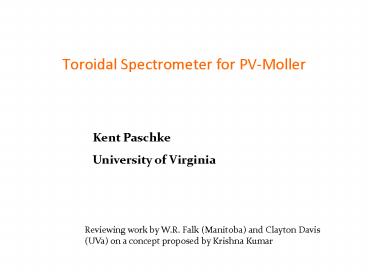Toroidal Spectrometer for PVMoller PowerPoint PPT Presentation
1 / 12
Title: Toroidal Spectrometer for PVMoller
1
- Toroidal Spectrometer for PV-Moller
Kent Paschke University of Virginia
Reviewing work by W.R. Falk (Manitoba) and
Clayton Davis (UVa) on a concept proposed by
Krishna Kumar
2
Introduction
- Goals
- maximize azimuthal acceptance
- block line-of-sight
- separate from ep scatter
- tight focus to limit background
- fit in Hall
- avoid creating new background sources
- etc...
All work shown here is preliminary conceptual
optics design. No radiative process or
backgrounds are shown. This is a promising
start, but much more work is required even to
establish feasibility.
3
Figure of Merit
Highest figure of merit at ?CM 90o
Only take forward or backward from center of
mass, otherwise you are only double-counting
(identical particles).
4
Energy/Angle Range
Backward (CMS) angles selected for ease (highest
lab angles)
An interesting proposition by KK To maximize
accept, start by throwing away half of your
azimuthal acceptance!
5
The ideal collimator
All of those rays of ?CM90,120 that you dont
get here...
... are collected as ?CM60,90 over here!
6
Energy/Angle Range
Range of angle 5.5 -17 mrad Range of energy
2.75-8.25 GeV
- This allows 50 of the azimuth for magnet
coils... plenty of space for coils! - Toroids naturally have rapid variation of field
with radius - Accepting high-momentum tracks means ep
backgrounds are closer... can they be removed
effectively?
Several apparently workable designs have been
found
7
Three Toroid Design
W.R.Falk design focus at 37 m
ee
meters
ep
(half of) open sector
(half of) coil sector
meters
- Three (resistive) 7-sector toroids
- Bend all tracks out, then slam high angle
(soft!) tracks back in to create focus - All (ideal) Moller tracks miss coils, but
azimuthal defocus fills full azimuth at focus - Slice shown with point target, extended target
broadens focus
8
Superconducting Toroid Design
W.R.Falk design focus at 32.5 m
ee
meters
ep
meters
- Resistive pre-bend toroid magnet,
superconducting toroid to bend hard tracks out
for focus - All (ideal) Moller tracks miss coils, but
azimuthal defocus fills full azimuth at focus - Slice shown with point target, extended target
broadens focus
9
Nested Toroid
- More complicated magnet geometry used to control
integral Bdl without extensive defocusing - Pre-bender magnet pushes highest angle tracks
above high field region, and focuses other tracks
meters
ee
ep
Overlap between neighboring sectors
Focus at 22.5 meters
meters
meters
- ep
- ee, 60o-75o
- ee, 75o-105o
- ee, 105o-120o
1.5 meter target, full range of theta and phi
meters
10
Nested Toroidal coils
6 separate current returns so downstream end of
magnet is much stronger than upstream end Very
modest power, 500 kW
- Small beam bore
- First magnet is close to target (6m to center).
Power density? - Complicated design... is it robust?
- Tighter focus, more separation?
11
Slices
12
Simplified Design is possible
Concept is robust over many changes. This
version is longer to the focus (30 m), with
slightly greater separation between Moller and
Mott scatters
This concept appears workable!
- Next Step
- GEANT MC needed to start looking at backgrounds
drives decisions on optics design, detectors,
collimation

